oil level YAMAHA XMAX 125 2017 Owners Manual
[x] Cancel search | Manufacturer: YAMAHA, Model Year: 2017, Model line: XMAX 125, Model: YAMAHA XMAX 125 2017Pages: 96, PDF Size: 8.13 MB
Page 5 of 96

Table of contents
Safety information............................1-1
Further safe-riding points ................1-5
Description........................................2-1
Left view ..........................................2-1
Right view........................................2-2
Controls and instruments ................2-3
Instrument and control functions....3-1
Immobilizer system .........................3-1
Main switch/steering lock ...............3-2
Indicator lights and warning
lights ............................................3-4
Multi-function meter unit .................3-6
Handlebar switches.......................3-13
Front brake lever ...........................3-14
Rear brake lever ............................3-15
ABS ...............................................3-15
Fuel tank cap.................................3-16
Fuel................................................3-17
Catalytic converters .....................3-18
Seat ...............................................3-19
Storage compartments .................3-20
Adjusting the shock absorber
assemblies .................................3-21
Sidestand ......................................3-22
Ignition circuit cut-off system........3-23
For your safety – pre-operation
checks...............................................4-1
Operation and important riding
points.................................................5-1
Starting the engine ..........................5-2
Starting off.......................................5-3
Acceleration and deceleration.........5-3
Braking ............................................5-4
Tips for reducing fuel
consumption ................................5-5
Engine break-in ...............................5-5
Parking ............................................5-6
Periodic maintenance and
adjustment........................................6-1
Owner’s tool kit ...............................6-2Periodic maintenance chart for the
emission control system.............. 6-3
General maintenance and
lubrication chart........................... 6-4
Removing and installing panels ...... 6-7
Checking the spark plug ................. 6-9
Engine oil ...................................... 6-10
Final transmission oil .................... 6-13
Coolant ......................................... 6-14
Air filter and V-belt case air filter
elements and check hoses........ 6-15
Checking the throttle grip free
play ............................................ 6-17
Valve clearance ............................. 6-17
Tires .............................................. 6-18
Cast wheels .................................. 6-20
Checking the front and rear brake
lever free play ............................ 6-20
Checking the front and rear brake
pads........................................... 6-21
Checking the brake fluid level....... 6-22
Changing the brake fluid............... 6-23
Checking and lubricating the
cables ........................................ 6-24
Checking and lubricating the
throttle grip and cable ............... 6-24
Lubricating the front and rear
brake levers ............................... 6-25
Checking and lubricating the
centerstand and sidestand ........ 6-25
Checking the front fork ................. 6-26
Checking the steering ................... 6-26
Checking the wheel bearings ....... 6-27
Battery .......................................... 6-27
Replacing the fuses ...................... 6-29
Replacing a headlight bulb ........... 6-30
Auxiliary light bulbs ....................... 6-31
Tail/brake light .............................. 6-31
Front turn signal light .................... 6-32
Replacing a rear turn signal light
bulb............................................ 6-32
Replacing the license plate light
bulb............................................ 6-33
Troubleshooting ............................ 6-34
Troubleshooting charts ................. 6-35
U2DME3E0.book Page 1 Friday, June 10, 2016 2:25 PM
Page 12 of 96
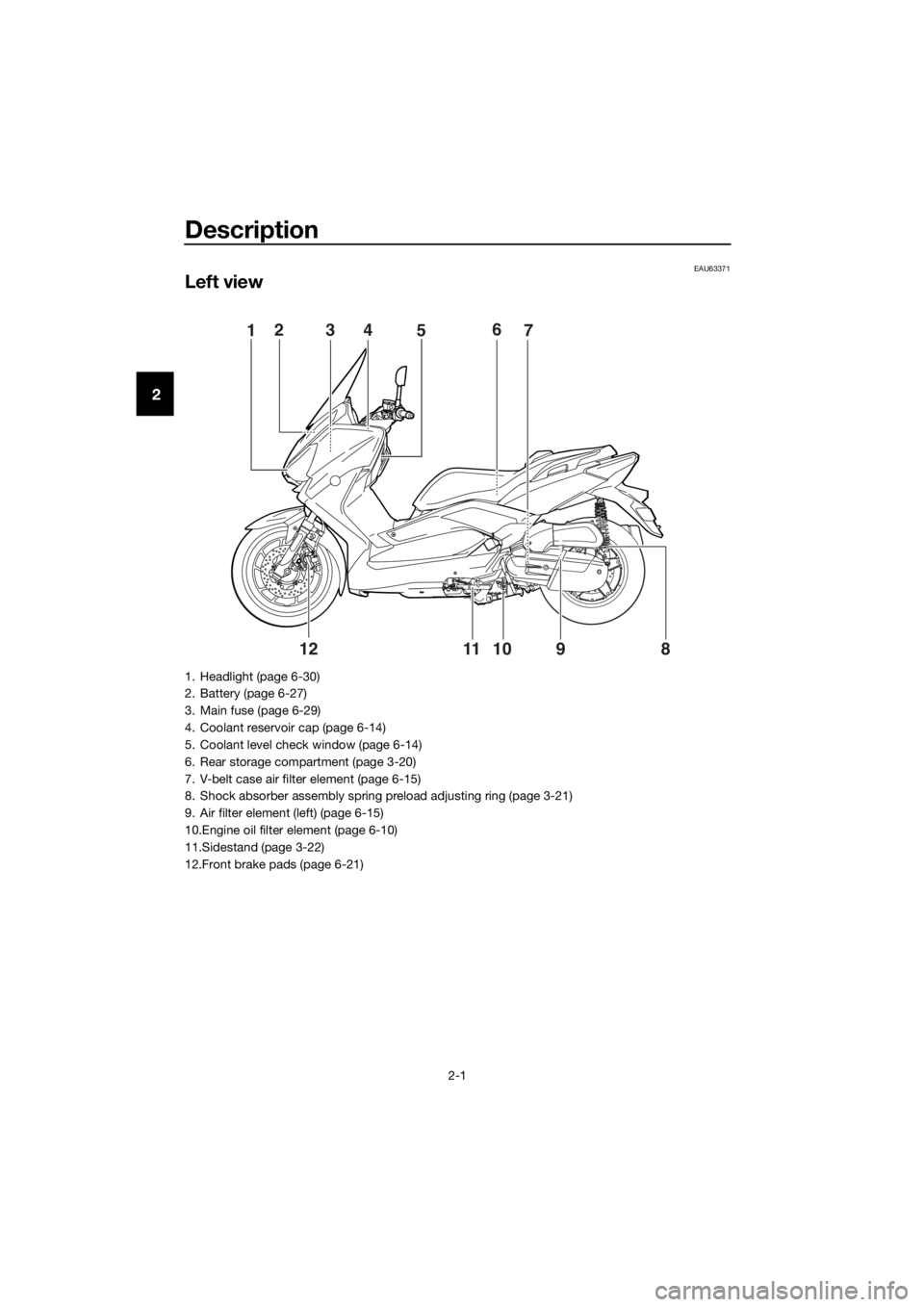
Description
2-1
2
EAU63371
Left view
7 615243
98 10 11 12
1. Headlight (page 6-30)
2. Battery (page 6-27)
3. Main fuse (page 6-29)
4. Coolant reservoir cap (page 6-14)
5. Coolant level check window (page 6-14)
6. Rear storage compartment (page 3-20)
7. V-belt case air filter element (page 6-15)
8. Shock absorber assembly spring preload adjusting ring (page 3-21)
9. Air filter element (left) (page 6-15)
10.Engine oil filter element (page 6-10)
11.Sidestand (page 3-22)
12.Front brake pads (page 6-21)
U2DME3E0.book Page 1 Friday, June 10, 2016 2:25 PM
Page 21 of 96
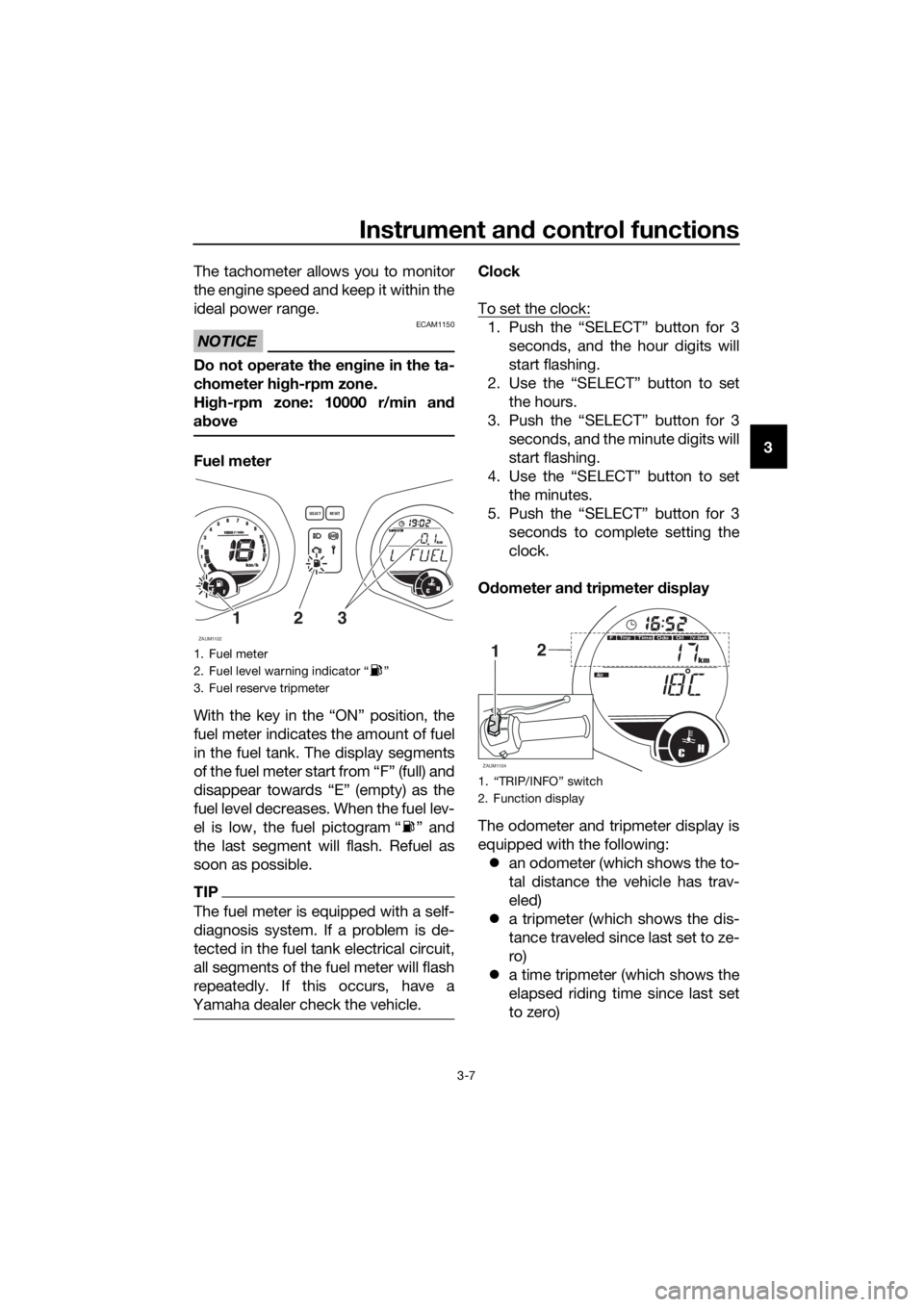
Instrument and control functions
3-7
3 The tachometer allows you to monitor
the engine speed and keep it within the
ideal power range.
NOTICE
ECAM1150
Do not operate the engine in the ta-
chometer high-rpm zone.
High-rpm zone: 10000 r/min and
above
Fuel meter
With the key in the “ON” position, the
fuel meter indicates the amount of fuel
in the fuel tank. The display segments
of the fuel meter start from “F” (full) and
disappear towards “E” (empty) as the
fuel level decreases. When the fuel lev-
el is low, the fuel pictogram “ ” and
the last segment will flash. Refuel as
soon as possible.
TIP
The fuel meter is equipped with a self-
diagnosis system. If a problem is de-
tected in the fuel tank electrical circuit,
all segments of the fuel meter will flash
repeatedly. If this occurs, have a
Yamaha dealer check the vehicle.
Clock
To set the clock:
1. Push the “SELECT” button for 3
seconds, and the hour digits will
start flashing.
2. Use the “SELECT” button to set
the hours.
3. Push the “SELECT” button for 3
seconds, and the minute digits will
start flashing.
4. Use the “SELECT” button to set
the minutes.
5. Push the “SELECT” button for 3
seconds to complete setting the
clock.
Odometer and tripmeter display
The odometer and tripmeter display is
equipped with the following:
an odometer (which shows the to-
tal distance the vehicle has trav-
eled)
a tripmeter (which shows the dis-
tance traveled since last set to ze-
ro)
a time tripmeter (which shows the
elapsed riding time since last set
to zero)
1. Fuel meter
2. Fuel level warning indicator “ ”
3. Fuel reserve tripmeter
ZAUM1102
98765432111 10
12
0
1000r/min
km/h
E
FCH
kmT
ripOdo
SELECTRESET
F
312
1.
2. Function display
ZAUM1104CH
km
Odo
Air
OilV-BeltTimeT
ripOdoF
21
INFOTRIP
U2DME3E0.book Page 7 Friday, June 10, 2016 2:25 PM
Page 22 of 96
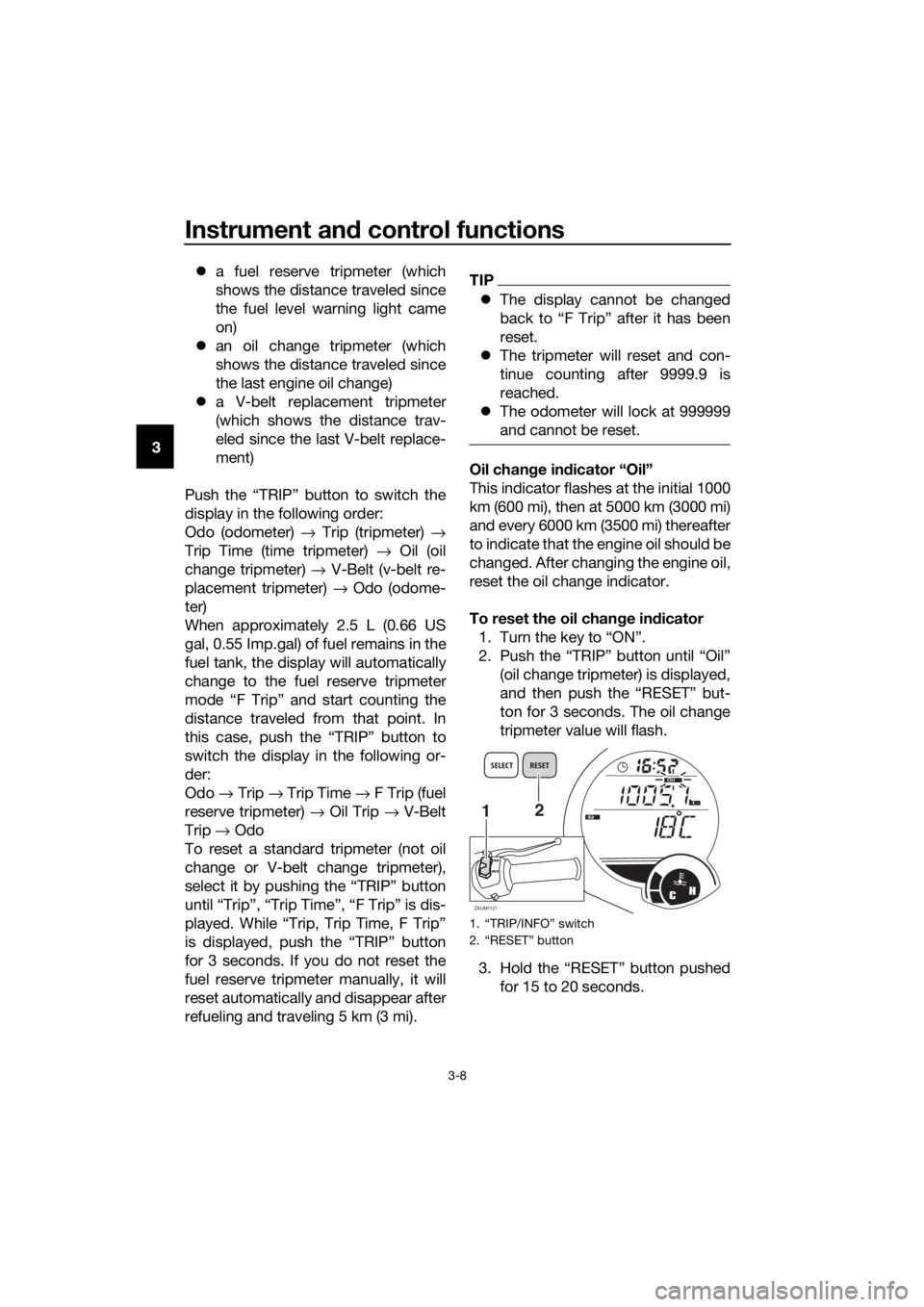
Instrument and control functions
3-8
3a fuel reserve tripmeter (which
shows the distance traveled since
the fuel level warning light came
on)
an oil change tripmeter (which
shows the distance traveled since
the last engine oil change)
a V-belt replacement tripmeter
(which shows the distance trav-
eled since the last V-belt replace-
ment)
Push the “TRIP” button to switch the
display in the following order:
Odo (odometer) → Trip (tripmeter) →
Trip Time (time tripmeter) → Oil (oil
change tripmeter) → V-Belt (v-belt re-
placement tripmeter) → Odo (odome-
ter)
When approximately 2.5 L (0.66 US
gal, 0.55 Imp.gal) of fuel remains in the
fuel tank, the display will automatically
change to the fuel reserve tripmeter
mode “F Trip” and start counting the
distance traveled from that point. In
this case, push the “TRIP” button to
switch the display in the following or-
der:
Odo → Trip → Trip Time → F Trip (fuel
reserve tripmeter) → Oil Trip → V-Belt
Trip → Odo
To reset a standard tripmeter (not oil
change or V-belt change tripmeter),
select it by pushing the “TRIP” button
until “Trip”, “Trip Time”, “F Trip” is dis-
played. While “Trip, Trip Time, F Trip”
is displayed, push the “TRIP” button
for 3 seconds. If you do not reset the
fuel reserve tripmeter manually, it will
reset automatically and disappear after
refueling and traveling 5 km (3 mi).
TIP
The display cannot be changed
back to “F Trip” after it has been
reset.
The tripmeter will reset and con-
tinue counting after 9999.9 is
reached.
The odometer will lock at 999999
and cannot be reset.
Oil change indicator “Oil”
This indicator flashes at the initial 1000
km (600 mi), then at 5000 km (3000 mi)
and every 6000 km (3500 mi) thereafter
to indicate that the engine oil should be
changed. After changing the engine oil,
reset the oil change indicator.
To reset the oil change indicator
1. Turn the key to “ON”.
2. Push the “TRIP” button until “Oil”
(oil change tripmeter) is displayed,
and then push the “RESET” but-
ton for 3 seconds. The oil change
tripmeter value will flash.
3. Hold the “RESET” button pushed
for 15 to 20 seconds.
1. “TRIP/INFO” switch
2. “RESET” button
ZAUM1121CH
kmAir
OilOdo
1
INFOTRIP
2
SELECT RESET
km
U2DME3E0.book Page 8 Friday, June 10, 2016 2:25 PM
Page 39 of 96
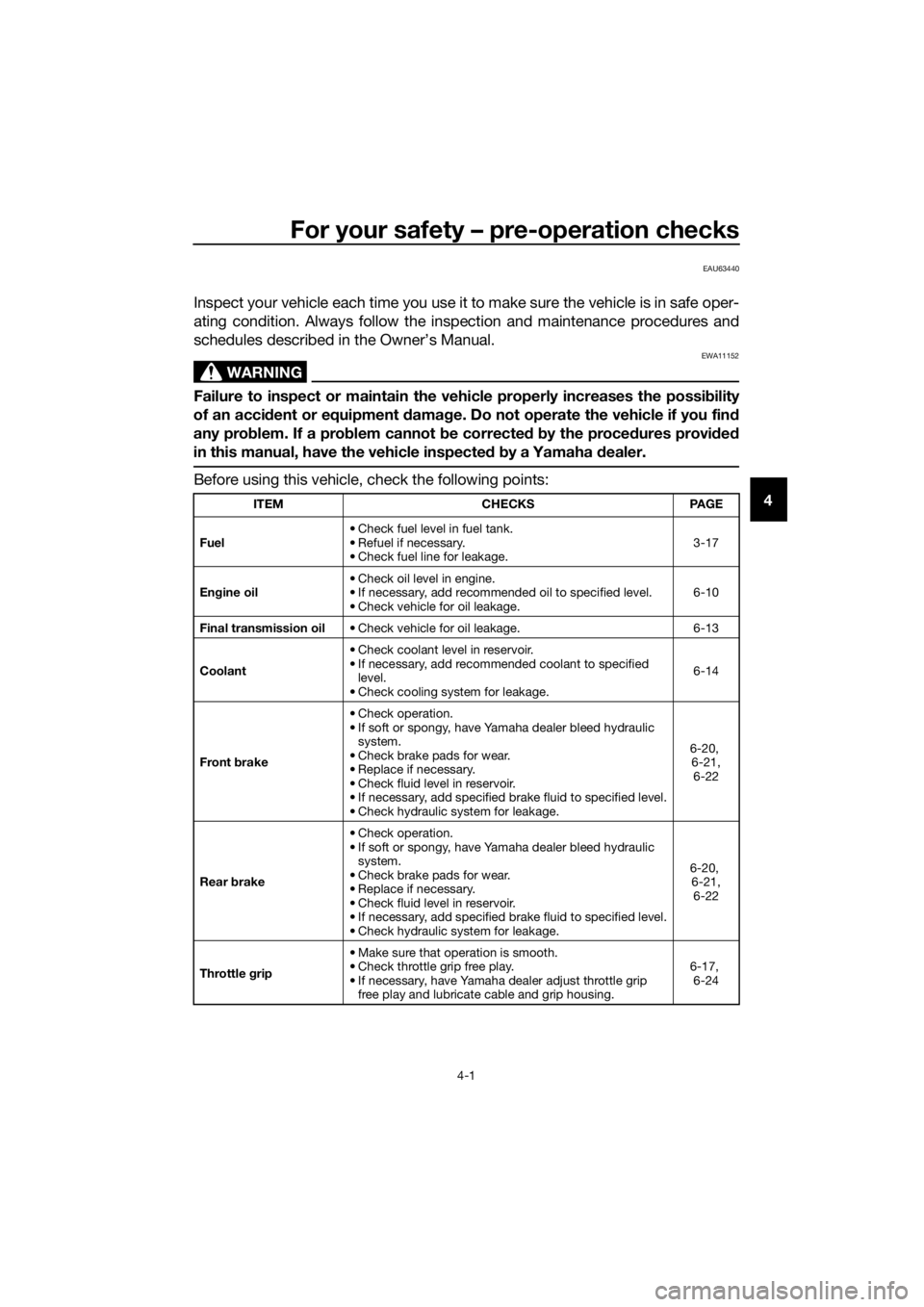
For your safety – pre-operation checks
4-1
4
EAU63440
Inspect your vehicle each time you use it to make sure the vehicle is in safe oper-
ating condition. Always follow the inspection and maintenance procedures and
schedules described in the Owner’s Manual.
WARNING
EWA11152
Failure to inspect or maintain the vehicle properly increases the possibility
of an accident or equipment damage. Do not operate the vehicle if you find
any problem. If a problem cannot be corrected by the procedures provided
in this manual, have the vehicle inspected by a Yamaha dealer.
Before using this vehicle, check the following points:
ITEM CHECKS PAGE
Fuel• Check fuel level in fuel tank.
• Refuel if necessary.
• Check fuel line for leakage.3-17
Engine oil• Check oil level in engine.
• If necessary, add recommended oil to specified level.
• Check vehicle for oil leakage.6-10
Final transmission oil• Check vehicle for oil leakage. 6-13
Coolant• Check coolant level in reservoir.
• If necessary, add recommended coolant to specified
level.
• Check cooling system for leakage.6-14
Front brake• Check operation.
• If soft or spongy, have Yamaha dealer bleed hydraulic
system.
• Check brake pads for wear.
• Replace if necessary.
• Check fluid level in reservoir.
• If necessary, add specified brake fluid to specified level.
• Check hydraulic system for leakage.6-20,
6-21,
6-22
Rear brake• Check operation.
• If soft or spongy, have Yamaha dealer bleed hydraulic
system.
• Check brake pads for wear.
• Replace if necessary.
• Check fluid level in reservoir.
• If necessary, add specified brake fluid to specified level.
• Check hydraulic system for leakage.6-20,
6-21,
6-22
Throttle grip• Make sure that operation is smooth.
• Check throttle grip free play.
• If necessary, have Yamaha dealer adjust throttle grip
free play and lubricate cable and grip housing.6-17,
6-24
U2DME3E0.book Page 1 Friday, June 10, 2016 2:25 PM
Page 42 of 96
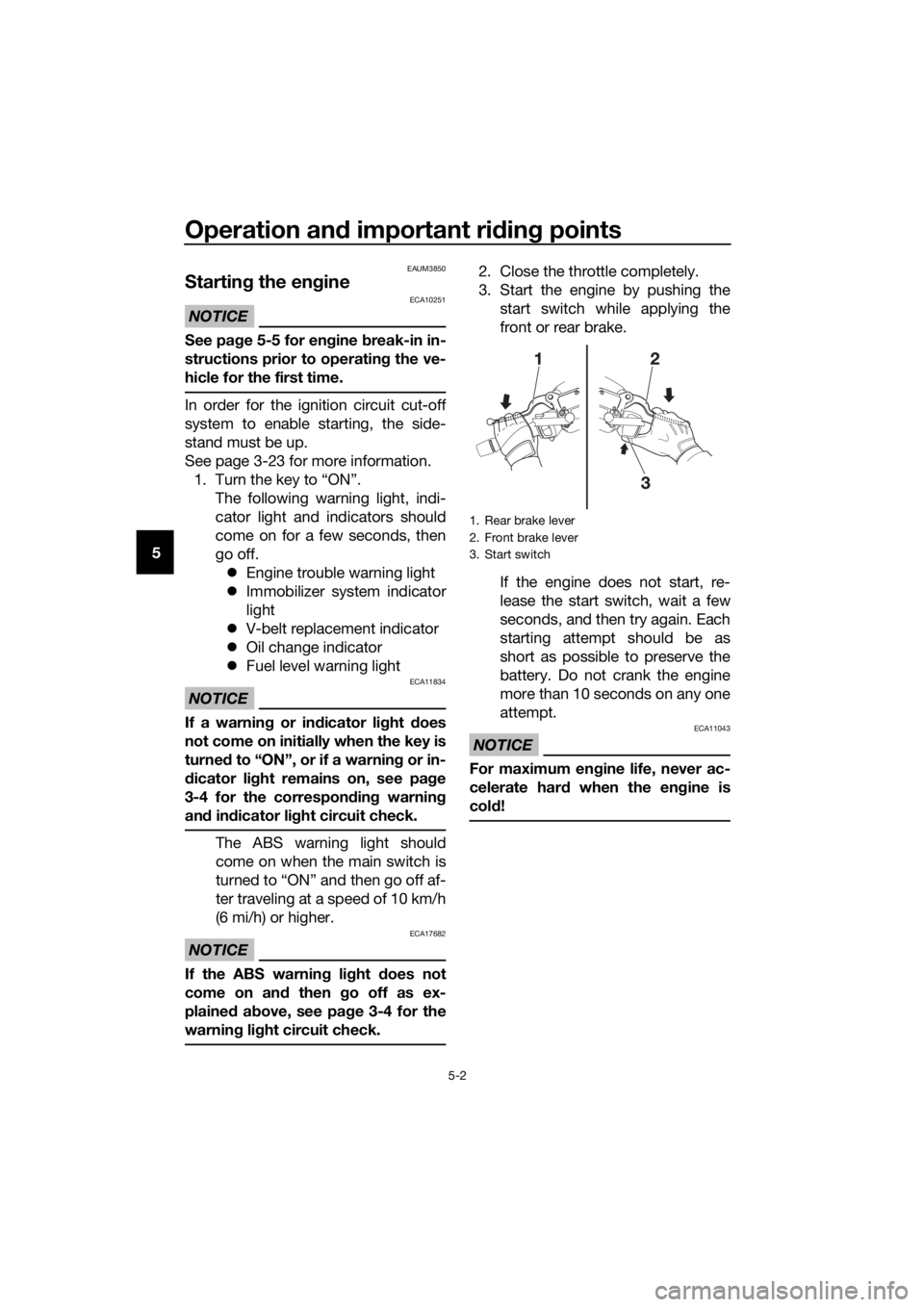
Operation and important riding points
5-2
5
EAUM3850
Starting the engine
NOTICE
ECA10251
See page 5-5 for engine break-in in-
structions prior to operating the ve-
hicle for the first time.
In order for the ignition circuit cut-off
system to enable starting, the side-
stand must be up.
See page 3-23 for more information.
1. Turn the key to “ON”.
The following warning light, indi-
cator light and indicators should
come on for a few seconds, then
go off.
Engine trouble warning light
Immobilizer system indicator
light
V-belt replacement indicator
Oil change indicator
Fuel level warning light
NOTICE
ECA11834
If a warning or indicator light does
not come on initially when the key is
turned to “ON”, or if a warning or in-
dicator light remains on, see page
3-4 for the corresponding warning
and indicator light circuit check.
The ABS warning light should
come on when the main switch is
turned to “ON” and then go off af-
ter traveling at a speed of 10 km/h
(6 mi/h) or higher.
NOTICE
ECA17682
If the ABS warning light does not
come on and then go off as ex-
plained above, see page 3-4 for the
warning light circuit check.
2. Close the throttle completely.
3. Start the engine by pushing the
start switch while applying the
front or rear brake.
If the engine does not start, re-
lease the start switch, wait a few
seconds, and then try again. Each
starting attempt should be as
short as possible to preserve the
battery. Do not crank the engine
more than 10 seconds on any one
attempt.
NOTICE
ECA11043
For maximum engine life, never ac-
celerate hard when the engine is
cold!
1. Rear brake lever
2. Front brake lever
3. Start switch
U2DME3E0.book Page 2 Friday, June 10, 2016 2:25 PM
Page 51 of 96

Periodic maintenance and adjustment
6-5
6
14Front brake lever
pivot shaft• Lubricate with silicone grease.√√√√√
15Rear brake lever
pivot shaft• Lubricate with silicone grease.√√√√√
16Sidestand, center-
stand• Check operation.
• Lubricate with lithium-soap-
based grease.√√√√√
17*Sidestand switch• Check operation and replace if
necessary.√√√√√√
18*Front fork• Check operation and for oil leak-
age.
• Replace if necessary.√√√√
19*Shock absorber
assemblies• Check operation and for oil leak-
age.
• Replace if necessary.√√√√
20 Engine oil• Change (warm engine before
draining).At the initial interval and when
the oil change indicator flashes
or comes on
• Check oil level and vehicle for oil
leakage.Every 3000 km (1800 mi)
21Engine oil filter el-
ement• Replace.√√√
22*Final transmission
oil• Check vehicle for oil leakage.√√√√√
• Change.√√√
23*Cooling system• Check coolant level and vehicle
for coolant leakage.√√√√√
• Change. Every 3 years
24*V-belt• Replace.When the V-belt replacement
indicator flashes [every 18000
km (10500 mi)]
25*Front and rear
brake switches• Check operation.√√√√√√
26*Moving parts and
cables• Lubricate.√√√√√ NO. ITEM
X 1000 km CHECK OR
MAINTENANCE JOB
X 1000 mi
ODOMETER
READING
ANNUAL CHECK
16121824
0.63.5710.514
U2DME3E0.book Page 5 Friday, June 10, 2016 2:25 PM
Page 52 of 96

Periodic maintenance and adjustment
6-6
6
EAU72780
TIP
Engine air filter and V-belt air filters
• This model’s engine air filter is equipped with a disposable oil-coated pa-
per element, which must not be cleaned with compressed air to avoid
damaging it.
• The engine air filter element needs to be replaced and the V-belt air filter
elements need to be serviced more frequently when riding in unusually wet
or dusty areas.
Hydraulic brake service
• After disassembling the brake master cylinders and calipers, always
change the fluid. Regularly check the brake fluid levels and fill the reser-
voirs as required.
• Every two years replace the internal components of the brake master cyl-
inders and calipers, and change the brake fluid.
• Replace the brake hoses every four years and if cracked or damaged.
27*Throttle grip hous-
ing and cable• Check operation and free play.
• Adjust the throttle cable free
play if necessary.
• Lubricate the throttle grip hous-
ing and cable.√√√√√
28*Lights, signals and
switches• Check operation.
• Adjust headlight beam.√√√√√√ NO. ITEM
X 1000 km CHECK OR
MAINTENANCE JOB
X 1000 miODOMETER
READING
ANNUAL CHECK
16121824
0.6 3.5 7 10.5 14
U2DME3E0.book Page 6 Friday, June 10, 2016 2:25 PM
Page 56 of 96
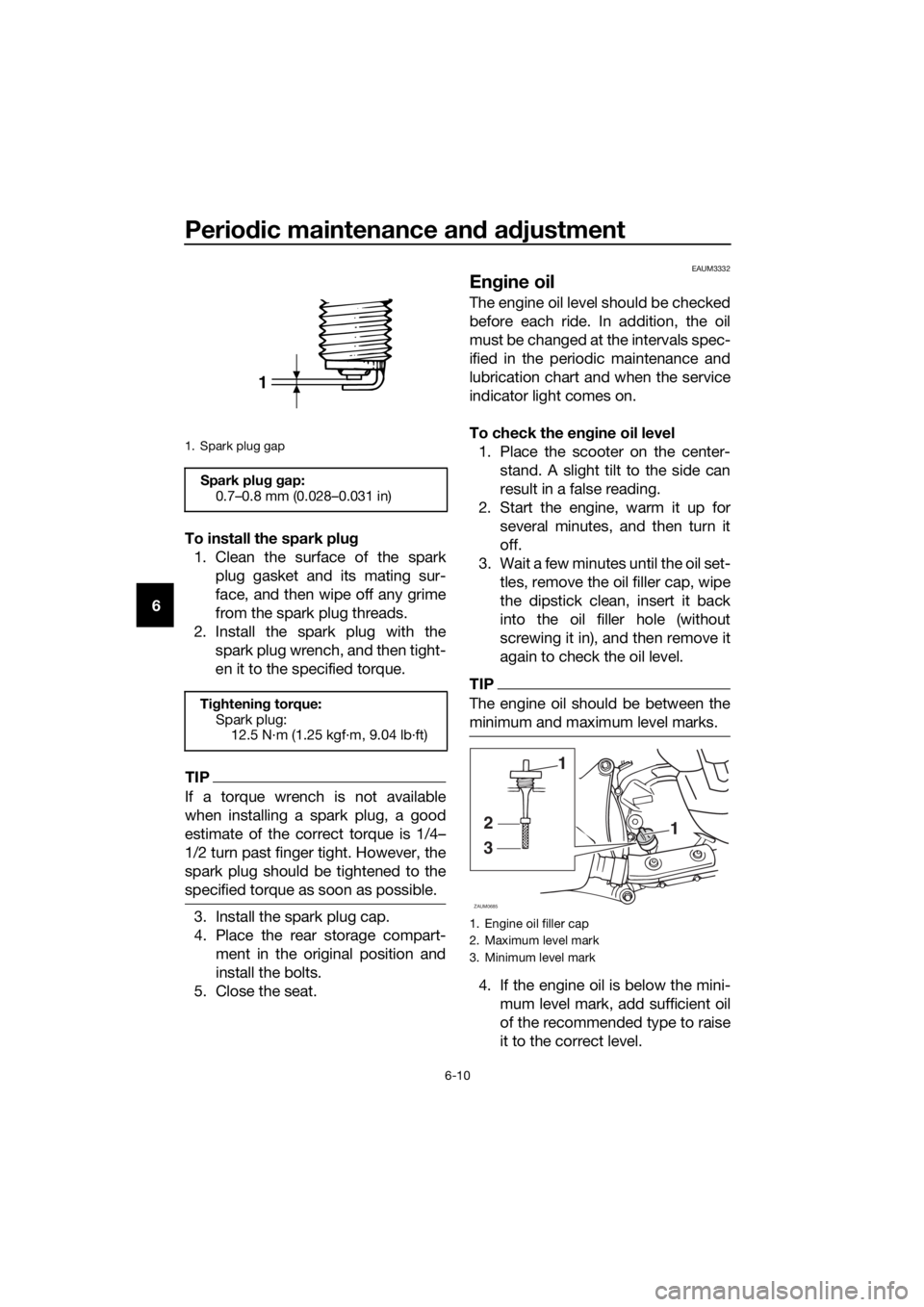
Periodic maintenance and adjustment
6-10
6To install the spark plug
1. Clean the surface of the spark
plug gasket and its mating sur-
face, and then wipe off any grime
from the spark plug threads.
2. Install the spark plug with the
spark plug wrench, and then tight-
en it to the specified torque.
TIP
If a torque wrench is not available
when installing a spark plug, a good
estimate of the correct torque is 1/4…
1/2 turn past finger tight. However, the
spark plug should be tightened to the
specified torque as soon as possible.
3. Install the spark plug cap.
4. Place the rear storage compart-
ment in the original position and
install the bolts.
5. Close the seat.
EAUM3332
Engine oil
The engine oil level should be checked
before each ride. In addition, the oil
must be changed at the intervals spec-
ified in the periodic maintenance and
lubrication chart and when the service
indicator light comes on.
To check the engine oil level
1. Place the scooter on the center-
stand. A slight tilt to the side can
result in a false reading.
2. Start the engine, warm it up for
several minutes, and then turn it
off.
3. Wait a few minutes until the oil set-
tles, remove the oil filler cap, wipe
the dipstick clean, insert it back
into the oil filler hole (without
screwing it in), and then remove it
again to check the oil level.
TIP
The engine oil should be between the
minimum and maximum level marks.
4. If the engine oil is below the mini-
mum level mark, add sufficient oil
of the recommended type to raise
it to the correct level.
1. Spark plug gap
Spark plug gap:
0.7–0.8 mm (0.028–0.031 in)
Tightening torque:
Spark plug:
12.5 N·m (1.25 kgf·m, 9.04 lb·ft)
1
1. Engine oil filler cap
2. Maximum level mark
3. Minimum level mark
1
3
2
1
ZAUM0685
U2DME3E0.book Page 10 Friday, June 10, 2016 2:25 PM
Page 58 of 96
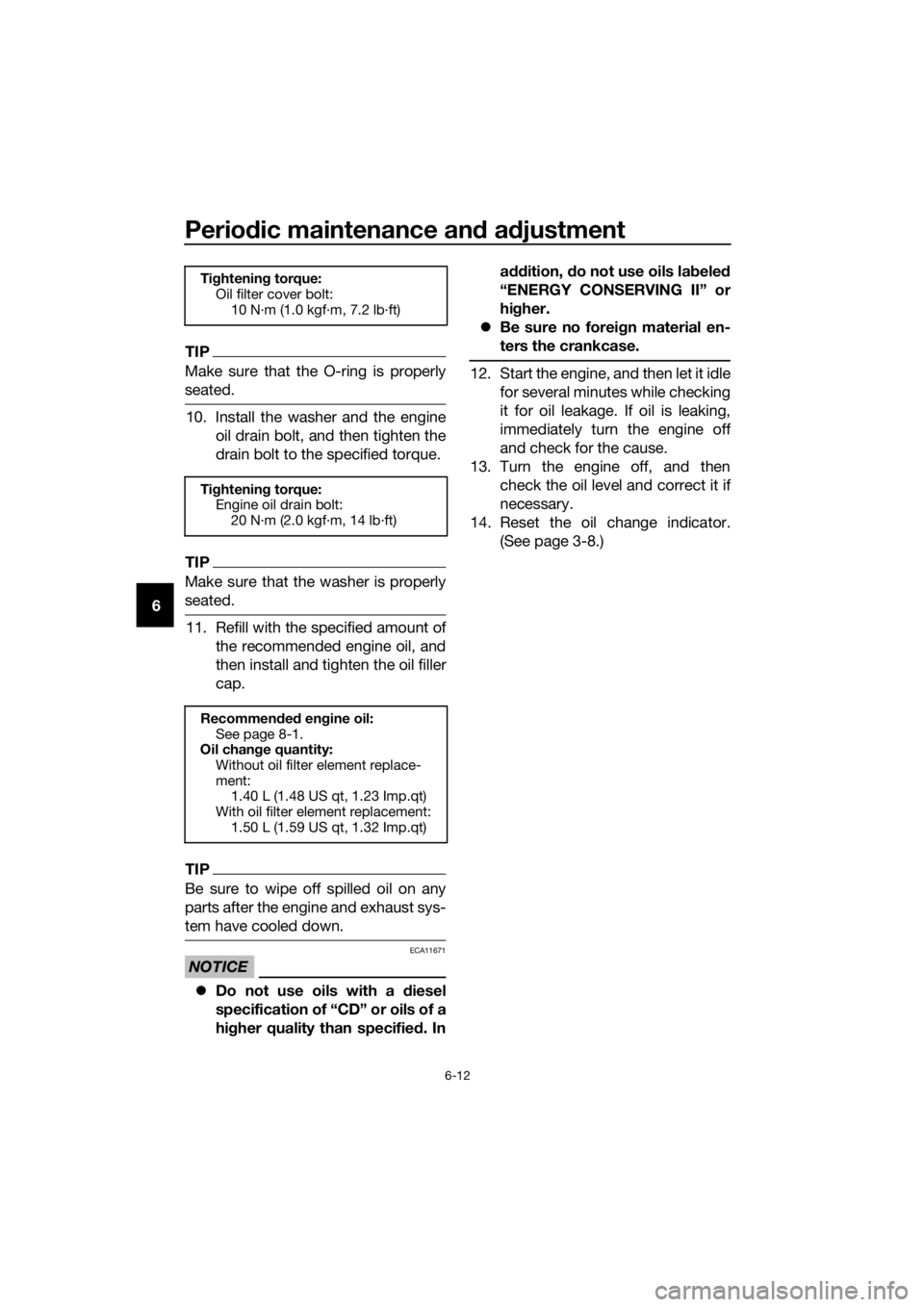
Periodic maintenance and adjustment
6-12
6
TIP
Make sure that the O-ring is properly
seated.
10. Install the washer and the engine
oil drain bolt, and then tighten the
drain bolt to the specified torque.
TIP
Make sure that the washer is properly
seated.
11. Refill with the specified amount of
the recommended engine oil, and
then install and tighten the oil filler
cap.
TIP
Be sure to wipe off spilled oil on any
parts after the engine and exhaust sys-
tem have cooled down.
NOTICE
ECA11671
Do not use oils with a diesel
specification of “CD” or oils of a
higher quality than specified. Inaddition, do not use oils labeled
“ENERGY CONSERVING II” or
higher.
Be sure no foreign material en-
ters the crankcase.
12. Start the engine, and then let it idle
for several minutes while checking
it for oil leakage. If oil is leaking,
immediately turn the engine off
and check for the cause.
13. Turn the engine off, and then
check the oil level and correct it if
necessary.
14. Reset the oil change indicator.
(See page 3-8.)
Tightening torque:
Oil filter cover bolt:
10 N·m (1.0 kgf·m, 7.2 lb·ft)
Tightening torque:
Engine oil drain bolt:
20 N·m (2.0 kgf·m, 14 lb·ft)
Recommended engine oil:
See page 8-1.
Oil change quantity:
Without oil filter element replace-
ment:
1.40 L (1.48 US qt, 1.23 Imp.qt)
With oil filter element replacement:
1.50 L (1.59 US qt, 1.32 Imp.qt)
U2DME3E0.book Page 12 Friday, June 10, 2016 2:25 PM